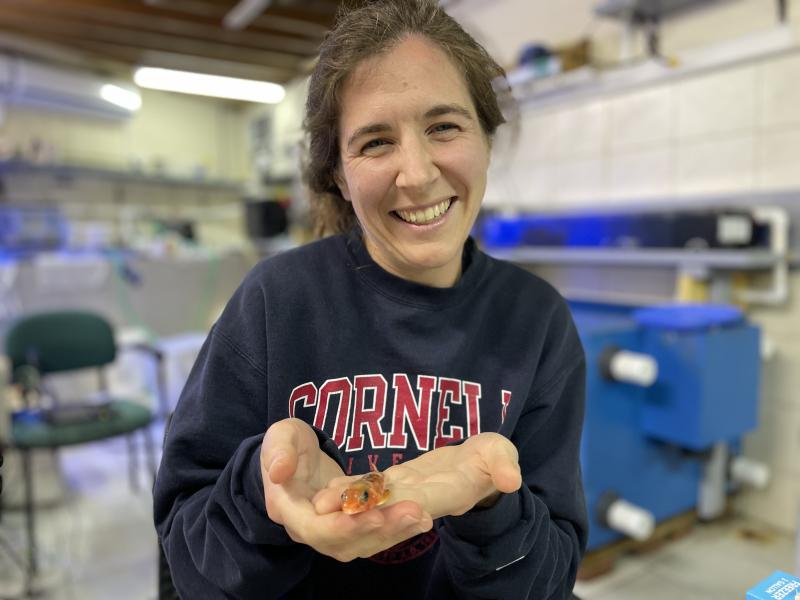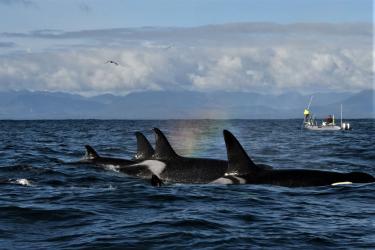To celebrate Women’s History Month, we’re introducing you to the extraordinary women of the National Systematics Laboratory. Dive in and meet Research Zoologist Dr. Katherine Bemis!
Mentors Matter
Research Zoologist Dr. Katherine Bemis’ passion for marine fishes started at a young age and was fostered by a number of important mentors. As a high school student, she began working with John Galbraith, a Fishery Biologist with NOAA’s Northeast Fisheries Science Center. “John has been an especially wonderful mentor to me throughout my career,” Bemis says.
“He showed me how to identify fishes. John always encouraged me to look closely at fishes under the microscope—and taught me that this would make me see and think about key characteristics for identification that I would otherwise overlook. This was something his mentors had taught him, which he passed on to me, and that I now teach my own students. Essentially, he taught me all the basics of what my job is now at the National Systematics Lab!”
During Bemis’ time working with Galbraith, he encouraged her to connect with his mentor, Bruce Collette, a Senior Scientist at the National Systematics Lab at the time. Bemis was ecstatic to learn more about the lab: “That’s the science that I’m really passionate about—using museum collections to study marine fishes,” she says. During her time as an undergraduate student, Bemis was selected for the Ernest F. Hollings Scholarship and received funding to work in a NOAA lab. She selected a project in the National Systematics Lab with Collette.
“The project that Bruce [Collette] outlined for me ended up taking much longer than the 10-week period of the scholarship, so I continued working with him when I went on to graduate school at the Virginia Institute of Marine Science. As I was completing my Ph.D., a position in the National Systematics Lab opened and a mentor encouraged me to apply, and that’s how I got here.”
Even as a full-fledged researcher, Bemis gains valuable insight from her mentors. She still collaborates with many of them, including Galbraith. The two of them recently co-authored a paper on amberjack life histories and identification. “One of the most satisfying parts of my job has been getting to intimately know the fishes of the western North Atlantic,” says Bemis. “I finally feel like I have a good handle on the diversity, but that wouldn’t have been possible without mentors like John, who continues to help me build my knowledge of fishes in the region.”
Now, Bemis pays the support she’s been shown forward by hosting and mentoring her own students. “I really love that about this position—that I can use my role to provide opportunities for students passionate about fishes,” she says.
International Connections
Since joining the National Systematics Lab, Bemis has been a part of a number of international projects in locations such as Curaçao and Japan. In Curaçao, Bemis joined a dynamic team of researchers for the Smithsonian Deep Reef Observation Project. The research program is dedicated to exploring marine life and studying deep reefs in the southern Caribbean.
Most recently, Bemis traveled to Okinawa, Japan to continue her ongoing research on the three-tooth puffer, a rare and unusual fish that is closely related to pufferfishes and porcupinefishes. She has studied three-tooth puffers both in museum collections and in captivity, thanks to collaborative relationships with Japanese researchers Atsushi Kaneko, Kiyomi Murakumo, and Dr. Taketeru Tomita at the Okinawa Churaumi Aquarium.
“My trip to Japan was really special, and it highlights how having collaborators can make studying fishes from all over the world accessible,” Bemis says. “The United States is home to a small portion of global fish diversity, so it’s important to form international relationships to develop a holistic view of biodiversity.
The Joy of Sharing Science
“I’ve always been interested in fisheries and natural history collections, and those two things come together at the National Systematics Lab. There aren’t many other places like that,” says Bemis. The lab’s unique location within the National Museum of Natural History provides Bemis with countless opportunities for collaboration, outreach, and mentorship.
This is hugely important to Bemis, who treasures her days on the water but is equally enthusiastic about the time that she gets to spend educating others and connecting over a shared love of the ocean. “My biggest achievement has been getting my position with the National Systematics Lab because it allows me to pursue all of my interests. I get to spend time in the field, at sea collecting specimens, and sharing my excitement about fishes with students and colleagues,” Bemis says.
One of the colleagues who Bemis frequently gets to share this excitement with is Dr. Abigail Reft, who works with Bemis to manage the Smithsonian’s marine fishes collections. “Abby [Reft] came to the National Systematics Lab shortly before I did, so we were both new and figuring out our positions together. Learning from Abby is one the highlights of my position,” Bemis says. “The National Systematics Lab is a really special unit.”






